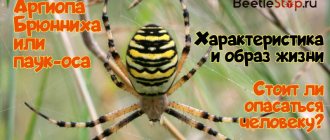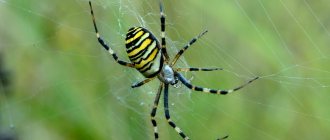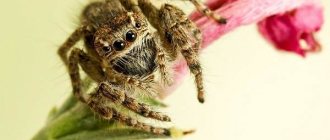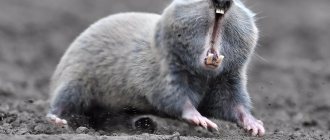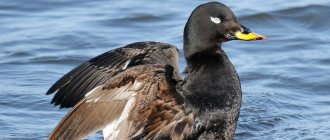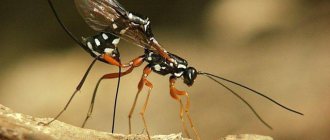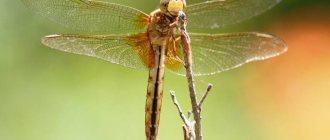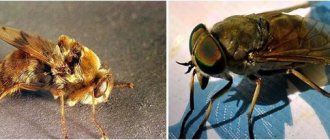The cross spider, or Araneus, belongs to the orb-weaver family, a genus of araneomorphic spiders. In total, there are more than 1000 species of representatives of this genus in the world, but in Russia and the CIS countries you can find from 15 to 30 species. Crosses live mainly in damp and damp places - in fields, meadows, forests, along the banks of reservoirs and rivers.
Features of the cross spider
Spiders are dioecious animals. After mating, the male dies, and the female begins to weave a cocoon from the web for eggs, which she usually lays in the fall. The cocoon turns out to be quite dense; the female carries it on herself for some time, and then hides it in any safe place - in a crack in the bark of trees or behind a loose piece of bark. In spring, young (juvenile) spiders emerge from the cocoon. They become sexually mature by the end of summer, after which the female that gave birth to them dies.
In the first days of his life, the male cross spider also builds a web - he needs to eat something. But upon reaching maturity, he begins to wander in search of adventure and, of course, noticeably loses weight. During this period, he is driven by only one desire - to find the female’s web.
When the female's web is found, he makes every effort not to get to her for lunch. To do this, he weaves a thread for himself down from the edge of the web - for retreat. Then he carefully tugs the thread. The female immediately rushes in search of prey, and the male retreats down the rescue thread.
This is repeated several times until the female understands that it is not the prey who is pulling the web, but her long-awaited partner. Then she changes her anger to mercy, and the spiders mate. But the male must not let down his vigilance, because... after mating, the hunting instinct awakens in the female again. If he does not escape in time, he may well be eaten.
Description of popular types
Common cross
It is the most common type among spiders with a cross on its back. This spider can be found in Europe and North America. This species prefers to settle in swamps, bushes, and also in coniferous forests. Females measure 20–25 mm, while males reach 11 mm in length and have a narrower body. Both sexes have a waxy coating on their bodies that retains water. The cephalothorax is under the reliable protection of a durable shell.
Angular cross
It is one of the rarest species. This species of arthropod is on the verge of extinction and is even listed in the Red Book of the city of St. Petersburg. The habitat of the angular cross is Europe, Asia, Russia and the northern part of Africa. A characteristic difference of this species is the absence of a cross of white spots. Instead of spots, the spider has 2 angular humps on its abdomen. The body of this species is covered with numerous light-colored hairs. Females reach 15–18 mm, and males grow to 10–12 mm.
Barn spider
This species can be found in the northeastern United States, North America, and also in Canada. Prefers to settle in places of rocky cliffs, near the entrance to mines. Females differ slightly from males in size. The female representative has a size of 13–22 mm, and the male grows to 10–20 mm. The body of the female is lighter or yellow, and the center of the belly is represented by brown, uneven edges in the form of jagged edges. At the bottom of the spider there is a dark stripe, and on top of a black background you can see two dazzling white spots.
Spider Pringles
He is a resident of India, Austria, Nepal. They named him after an interesting pattern on the upper part of his abdomen, reminiscent of a mustachioed guy from a package of well-known chips. While hunting, spiders sit in a shelter with a signal thread, which is triggered when the prey falls into the trap. These spiders are small in size. The female grows up to 6–9 mm, and the male up to 3–5 mm.
Meadow cross
This spider can be found in damp areas with densely planted grass. In shape and size it can be compared to an ordinary cross. The characteristic spots in the form of a cross on the belly have a dark or light shade, depending on the color of the surface of the abdomen. At the bottom you can see a blurry leaf-shaped design. The body is light green or dark brown. Light colored stripes can be seen on the paws. The female grows up to 17 mm, and the male is only 8 mm in length. Adult females have the properties of a chameleon, in other words, they can blend in with their environment.
Chilly cross
This species is a lover of temperate climates. Lives in forests with deciduous trees. In appearance it resembles a meadow cross. The difference is the color of the spider. The color of this species is predominantly beige and orange. The abdomen has numerous light-colored specks, which makes it resemble a strawberry. The female reaches 13 mm in length, and the male is only 6 mm.
Oak cross
The favorite habitat of this spider is thickets of bushes, as well as tall grass. The spider prefers temperate climates. A distinctive feature of this species is the abdomen of females, which is pointed at both ends. It also has numerous hairs covering the cephalothorax. Against the background of the brown belly, you can see a white herringbone pattern. In the lower part of the belly there is an elongated yellow spot. The female reaches 14 mm in size, and the male grows to 7–8 mm.
Cat-faced spider
Lives in the western part of the USA, as well as in Canada. The body, covered with villi, can have a dark or light color. In the place where the cross should be there is a drawing that resembles a cat's face. The size of the female of this arthropod is 13–25 mm, and the male reaches up to 8 mm in length.
Video
Reproduction of the cross spider
The cocoon, which the female weaves in autumn, contains from 300 to 800 amber-colored eggs. Under the protection of the cocoon, future spiderlings are not afraid of either cold or flood - it is very light and does not get wet. The eggs wait out the winter in the cocoon, and in the spring small spiders emerge from the eggs. For some time they sit inside the cocoon, afraid to leave such a cozy shelter. But gradually they spread out and begin to live on their own.
It is clear that it will be very difficult for such a huge offspring to get settled in life. Competition is very high, some will die of hunger, and others will be eaten by their relatives. Therefore, the young spiders face a serious task - to disperse as quickly as possible in order to increase their chances of survival.
Their legs are small and weak, so the spiders move, gliding with the help of their web, like real aeronauts. With a fair wind, a spider can fly a distance of 300-400 km. When the wind subsides, the web falls to the ground, the spider throws it away and begins to settle in a new place. If he is lucky with the site, he will be able to catch up to 500 insects per day with his nets. The hunt is ongoing.
According to naturalists, millions of spiders live in meadows, fields and forests, destroying entire legions of insects, including those dangerous to humans and their households. If it were not for spiders, the number of flies, mosquitoes, gnats, midges, moths and aphids would be several orders of magnitude greater and could seriously poison our lives. Experts do not even exclude the possibility of using spiders in biological pest control.
First aid for a bite
To minimize the consequences of a spider bite with a cross on the back, do not neglect first aid. It should be remembered that along with the poison, an infection can get into the wound, which will cause no less harm, and maybe even more, than the toxin itself. What should you do first?
- Wash the bite area thoroughly with cold running water and soap.
- If the swelling is severe, apply a cold compress, or you can use ice for a short time.
- Take an antihistamine, for example, suprastin, loratadine, zodac.
- After some time, an ointment that relieves itching and swelling (fenistil, sinaflan) can be applied to the affected area.
If a child is bitten by a spider, do not wait for a reaction to the poison to appear; consult a doctor immediately.
Possible consequences after a cross bite
The venom of the cross spider is toxic, like that of all arachnids. A toxin called “Thermolabile hemolysin” is capable of destroying human red blood cells, however, its toxic effect is rather local in nature, not spreading to the entire body. That is why the bite of the cross spider is practically harmless. However, sometimes after a spider bite the following symptoms of poisoning can be observed:
- headache or slight dizziness;
- slight weakness in the body;
- short-term aches in the joints;
- the bite site will almost always hurt and, in the future, itch;
- subcutaneous hemorrhages are possible, which looks like a bruise around the bite;
- there is also always slight swelling and redness;
- an allergic reaction is possible, but weak, and in extremely rare cases;
- Sometimes local muscle necrosis is observed after wound healing, but rarely.
The worst that can happen is blood poisoning with subsequent complications. The infection can enter the bloodstream if the wound is not treated with antiseptic agents in a timely manner or if the bite site is actively scratched. Below are several photos of a spider bite, including inflamed ones.
Web of the cross spider
Cross spiders catch their prey using webs. More precisely, their females - male spiders do not weave webs. Female spiders guard their prey either in the center of the web or sitting next to it, on a signal thread. Mostly flies or mosquitoes get caught in the web. If it comes across prey that is too large and inedible, for example a wasp, the spider can free it by tearing off the web.
The spider either eats the caught prey immediately on the spot, or, if it is not too hungry, drags it into a secluded corner or entangles it in a web. Around the web, under the leaves, you can find a whole food warehouse of flies entangled in the web, stored for a rainy day.
Precautionary measures
Even if the bite is not fatal, it can cause a lot of trouble.
To avoid this you need to follow some rules:
- When spending the night in nature, you have to sleep in a tent, so before spending the night, check the fabric room for an invasion of “eight-legged guests.”
- Before putting on clothes and shoes, check for spiders inside. The same applies to bedding.
- If you find a web, it is better not to contact it, since only “evil” female crosses weave webs.
- If there is a spider in front of you, you should not run away; it is better not to do anything at all and protect small children from it.
Sources
- https://ykys.ru/ukus-pauka-krestovika/
- https://domvred.ru/pauk-krestovik/
- https://usatym.net/prochie/pauk-krestovik-opisanie-stroenie-gde-obitaet-pitanie/
- https://WikiParazit.ru/pauki/pauk-krestovik.html
- https://BaikalHangkai.ru/koshki/dyhanie-pauka-krestovika.html
- https://dezplan.ru/vopros/pauk-krestonosec
- https://givotniymir.ru/pauk-krestovik-obraz-zhizni-i-sreda-obitaniya-pauka-krestovika/
- https://beetlestop.ru/pauk-krestovik/
- https://prusakam.net/pauk-krestovik/
- https://halal-eko.ru/rybki/stroenie-pauka-krestovika.html
- https://bioros.net/nasekomye/kak-raspoznat-pauka-krestovika-i-naskol-ko-on-opasen.html
- https://nashzelenyimir.ru/%D0%BF%D0%B0%D1%83%D0%BA-%D0%BA%D1%80%D0%B5%D1%81%D1%82%D0%BE% D0%B2%D0%B8%D0%BA/
- https://beetlestop.ru/pauk-s-krestom-na-spine/
- https://parazitdoma.ru/drugie-parazity/pauk-krestovik
- https://kopejsk.ru/opisanie/opasen-li-dlya-cheloveka-pauk-krestovik.html
[collapse]
The behavior of the cross spider
How does a spider hunt? When a fly or any other insect gets caught in a web, the spider senses the vibration of the trapping web, it crawls into the victim and kills it with a bite of its poisonous mandibles, or chelicerae. The fly stops shaking the web, and the spider calmly swaddles it with a bundle of thin threads, pulling them out of the abdomen with a pair of its legs.
Having snacked on the surrounding threads, the spider takes its breakfast and goes to the center of the web to have a meal. He crushes his prey, injecting digestive juices into it. When the fly has digested inside its shell, the spider sucks up the semi-liquid contents into which the fly has turned and throws away the victim’s skin. During a successful hunt, a spider can eat about a dozen flies in one sitting. The venom of cross spiders is dangerous only for small insects; it cannot harm humans.
World of small creatures
Insects are small organisms whose size does not exceed a few centimeters. Their structure does not allow increasing volume and weight in modern conditions. This cannot be said about the ancient arthropods that lived during the time of dinosaurs and even earlier. In those days, the atmosphere was completely different: the air density and gas composition were different. And planet Earth itself weighed less. In the distant past, dragonflies reached sizes of more than half a meter.
What do insects breathe? And what prevented them from evolving to the size of, for example, a cat in modern conditions? Scientists believe that this is a kind of respiratory system.
Habitat of the cross spider
Crossworts live mainly in the crowns of trees, make a secluded shelter from the leaves, and stretch the web between the branches. The wheel-shaped web can be found in a forest, grove or neglected garden. Sometimes it can be found in bushes or in window frames and under the eaves of abandoned houses.
The trapping web constantly requires repair, it is destroyed by both small and large insects, so every couple of days the cross spiders unravel the web and make a new one. They usually do this at night, and by morning the new web is ready for new prey. Thus, at night the spider is relatively safer, because its natural enemies, insectivorous birds, sleep at night. It does not need light to build a web; a well-developed sense of touch is sufficient.
The enemies of the cross spider are also flies and wasps, which lay eggs in the bodies of their victims. For example, the fly Melanophora rugalis - taking advantage of the spider’s immobility, it can fly up to it, sit on its back and in the blink of an eye lay an egg in its body.
A bit of Wikipedia
There are more than 600 species of cross spiders in the world fauna. About 30 species are found on the territory of Russia and post-Soviet countries. All of them have characteristic white or yellowish spots on their backs, from which a cross pattern is formed, which is why they are called “crosses.”
The cross spider is considered a small spider. Although quite large specimens can rarely be found, especially in places remote from civilization. Here are a few photos of cross spiders that are found in our latitudes.
When meeting a person or animal that is clearly larger than its size, crosses hide and are never the first to attack. Their food is small insects, mainly flies. They do not show aggression towards others.
Web of the cross
The web of the female cross has exactly 39 radii, 1245 points of attachment of the radii to the spiral and 35 turns of the spiral - no more, no less. The webs of all spiders are as similar to one another as two peas in a pod, because all the necessary data is genetically enshrined in their heredity. Therefore, even small spiders know how to build webs and catch prey.
Any web is not only beautiful in its symmetry and delicacy, it is very rationally arranged. All the threads that form it are very light and, nevertheless, very strong, and are connected in such a way that they only work to break.
How does a spider manage to build such an even, symmetrical web that is several dozen times larger than itself? A spider (more precisely, a cobweb), having climbed onto a branch or tree trunk, releases a long web thread from its abdomen. It is picked up by a stream of air, and the spider waits patiently until the thread catches on something suitable.
If this does not happen and the thread hangs, the spider pulls it towards itself and eats it. Then he runs to another place and tries again. And so on until the thread is caught. Then the spider crawls to the hooked end of the thread and secures it well. Then it descends on its thread to some support. There he also firmly fastens this thread - now 2 threads are already fastened.
The spider returns along the second thread and drags along the third, which it secures at the starting point, i.e. where the first thread came from. The triangular frame - the basis of the future web - is ready. Inside this frame, the spider stretches several threads that intersect in the center. The spider marks the center of the web with a lump and begins to extend all its numerous radii from it, fastening them with a spiral thread, and then lays trapping threads. At the intersection points of the spiral and the radius, the spider binds them with its legs.
Note that the angles between all radii and the distance between the turns of the web are strictly constant values. How does such a small creature manage to maintain its web in strict accordance with geometry? For this you need at least the simplest measuring device. And, imagine, the spider has it! This is his first pair of legs that can act as a scale ruler.
While working on the web, the crossmaker regularly checks the distance between the spirals. His natural tool is so precise and reliable that it allows you to work in pitch darkness. The last step in creating a web will be a signal network, the end of which is laid to the spider’s shelter. To build the entire web, the spider requires several hours of painstaking work and approximately 20 meters of web.
From a chemical point of view, the web is a complex protein polymer - fibroin. The many glands of the spider's abdomen form this viscous liquid, which quickly solidifies in air in the form of thin filaments. The spider can produce several different types of web with different properties. For the frame of the web he makes a dry and thick thread, for the cocoon - silky and soft, for the catching spiral - thin and sticky. Why doesn't the spider itself stick to its web? Everything is very simple - he runs only on non-adhesive threads, and diligently avoids touching adhesive spirals.
The polymer liquid comes out from the glands on the spider's abdomen through thin tubes and hardens into very thin threads. If the spider needs special strength, it can weave several of these threads together. In recent years, scientists have been seriously studying the properties of spider “silk”. It turned out that it has many unique properties.
The technology for producing spider web threads is similar to the production of synthetic fibers. But in terms of strength, no synthetic fiber can compare with spider fiber - it can withstand loads of up to 260 kg per 1 sq. mm, which is stronger than steel. This is why residents of the tropics make nets from spider webs to catch birds, bats, insects, and even weave fishing gear.
The web is so elastic that it can stretch up to 30% of its length and shrink back to its original length. Its lightness and subtlety are involuntarily amazing, because 340 grams of web is enough to encircle the globe at the equator!
Interesting Facts
A spider with a cross has the following features:
- The web of the cross is of great interest. It is elastic and has high strength. Since ancient times it has been used to make fabrics or decorations. People from tropical countries weave nets and nets from it to catch fish.
- Microbiologists have also not ignored the spider web. They use it to determine the composition of atmospheric air, as well as to produce the thinnest optical fiber.
- Interestingly, spiders move freely through their trapping webs and do not stick to them. This is explained by the fact that they move along radial, dry threads.
Crossmen are unique creatures. They can be very useful for a person. But if, due to an unfortunate combination of circumstances, the arthropod still bites, then first aid measures should be taken. But there is no reason to seriously fear for your health after this.
The use of cobwebs in agriculture and medicine
People have long tried to make fabric based on spider webs. In Germany, back in the 16th century, ribbons and various decorations were woven from cobwebs in villages. Then in France, artisans came up with the idea of making gloves and stockings from spider webs, which caused complete delight among fashionistas.
But it turned out to be impossible to launch this technology into large-scale production, and this was convincingly proven by the physicist and zoologist Reaumur. For such production to become profitable, it is necessary to contain and feed hundreds of thousands of spiders. But to feed them, it would be necessary to catch several million flies every day, which was completely impossible to implement in practice.
However, people still use the web, even today. For sights (crosshairs) in various optical instruments (microscopes, telescopes, sights, etc.), spider webs are simply ideal. Microbiologists have also found use for it, developing a unique air analyzer using it.
The cross spider is launched onto a special frame, fed, and the spider weaves its web based on this frame. Then air is pumped through a frame with a net, and the thinnest web perfectly captures the microbes that are in the air. This method of air analysis has been recognized as the most effective of all existing in the world.
In folk medicine, spider webs have been used since ancient times to disinfect open wounds. Research has confirmed that spider webs kill pathogenic bacteria, and with its help, drugs have been developed that are harmless to animals, but deadly to all kinds of bacteria. As you can see, the cross spider is extremely useful for humans, in every sense.
Pavuk khrestovik
The spider spider is classified as an arthropod, a representative of the spider-like class. Pavuk-khrestovik his zdobich to catch for additional pavutini. The spinning apparatus of spiders is made up of external structures - spider warts - and internal organs - spider veins. Three pairs of spider web warts grow on the back end of the petiole. This skin wart is pierced at the end with a hundred different openings. From the skin opening a speck of sticky thread is woven, like a spider weaving into the thinnest thread in Russia. These threads become angry and thicken in the wind. The result is a thin, scarlet thread. This kind of glue can be seen in numerous cobwebs growing in the back of the stalk. Ducts open on their spider warts.
To create your trap, the web spider attaches a thread in a number of handy places, creating a frame for the web in the appearance of an irregular spider web. Then dry up to the middle of the upper thread and, going down, draw a vertical thread. From the middle of the thread, as in the center, draw the threads to all sides, to the front of the wheel spokes. This is the basis of all spider webs. Then the spider begins to draw circular threads from the center, attaching them to the skin radial thread with a drop of adhesive tape. In the middle of the border, where the spider itself sits, the circular threads are dry. Other threads are covered with specks of very sticky core and therefore glued.
Characteristic
This spider belongs to the orb weaver family. Cross spiders are considered the most common type of spider. Researchers have found that they live almost all over the world. True, they do not at all favor the climate of southern and northern latitudes. Arachnids live in places with high humidity. Therefore, the spider web is found in thickets near rivers or lakes. They happily live on garden and forest trees. They prefer to weave a network in their crowns.
Rice. 1. Spider Araneus cavaticus on a catching net After studying the life of the spider spider, scientists gave it the following classification:
- relates to the animal kingdom;
- is of the phylum arthropod;
- belongs to the class Arachnida and the order Spiders;
- suborder: araneomorphic spiders;
- family Araneidae and genus - crosses.
Latin name Araneus.
Internal structure of arachnids
The respiratory system of the cross spider is represented by pulmonary sacs and trachea. The pulmonary sacs and trachea of arachnids open outwards with special openings on the lateral parts of the segments. The pulmonary sacs contain numerous leaf-shaped folds in which blood capillaries pass.
The trachea is a system of branched tubes that connect directly to all organs where tissue gas exchange takes place.
Internal structure of arachnids
The circulatory system of arachnids consists of a heart located on the dorsal side of the abdomen and a vessel through which blood moves from the heart to the front of the body. Since the circulatory system is not closed, blood returns to the heart from the mixed body cavity (mixocoel), where it washes the lung sacs and trachea and is enriched with oxygen.
The excretory system of the cross spider consists of several pairs of tubes (Malpighian vessels) located in the body cavity. Of these, waste products enter the posterior intestine.
The nervous system of arachnids is characterized by the fusion of nerve ganglia with each other. In spiders, the entire nerve chain merges into one cephalothoracic ganglion. The organ of touch is the hairs covering the limbs. The organ of vision is 4 pairs of simple eyes.
This is interesting
- How do crusading spiders move along their own web, since its threads are covered with an adhesive substance? The fact is that this arthropod moves along radial threads on which there is no adhesive substance, so it does not stick.
- The web of the cross can show the composition of the air, which is why it is so actively used in microbiology.
- Spiders aren't the only ones who need webs. Thanks to the strong threads of the cross spider's web, some tropical residents use it to weave jewelry, fishing gear, and also to make fabrics.
Budova pavuka-khrestovika
The cross spider is the most common creature of our forests. This spider, which is yellowish-brown or even blackened with bark, can be easily recognized by the white cross-like flame on the dorsal side of the body. These peculiarities of this type are called chrestovika. His zabarvlennya may be of the greatest significance; there is no way to stop him in the dark in the middle of the thick tea leaves, between the bushes of the trees.
With these signs of the future, the cross spider predicts the crayfish, and at the same time reveals a number of features associated with a different way of life. The class of spider-like creatures changed during the gradual transition from an aquatic to a terrestrial way of life. Like the crayfish, the body of the spider-like class (the spider spider) consists of two sections: the cephalothorax and the petiole. The ale stalk is very swollen and undifferentiated. In contrast to crustaceans, there are no whiskers on the head of the spider spider. The spider spider, like the tick, has no folding eyes. On the upper side of the head there are very simple glasses, and on the lower side, near the mouth, two pairs of slits. Spiders are tiny creatures. The stinks are grubby the mosquitoes. With the front pair of slits, the spider drives the bean. At the base of the cracks there are ruined vines. When the claws that end the cracks crash into the wound, the cuttings flow into the wound and kill the victim.
With another pair of slits, the spider grazes the zdobich. Behind the cracks there are rotted pairs of long walking legs. Like crayfish, the spider's legs are folded into round joints. The skin of the leg ends in jagged claws, so the spider can run on its net without getting lost in it. Claws also help spiders weave cobwebs. When replacing crayfish with brooches, there are no endings.
Arachnids
This net has over 100,000 of these little dots. Mosquitoes stick to them with their wings and paws and swoop down on the edge. The spider itself either hangs head down in the center of the spider web, or hangs to the side under the leaf. In this case, a signal thread is stretched to itself from the center of the web.
When a housefly gets caught in the middle, the spider, having sensed the three-ton signal thread, rushes out of its hiding spot. With open claws, the spider kills the victim and sees herbal juices in its body. After which he wraps a fly or another mosquito with cobwebs and deprives it for an hour.
Under the influx of herbal juices, the internal organs of the spider's victim are quickly poisoned. After about an hour, the spider turns to the victim and extracts all the living words from it. As mosquitoes in the web lose only their empty chitinous covering.
A prepared trap is a series of unrelated actions interconnected. The passion for such actions is instinctive and is transmitted spasmodically. It’s easy to overcrowd, following the behavior of young spiders. If the smell comes out of the eggs, no one will recognize them as working as a catcher, but the spiders will immediately smell the spider.
More tests
- Anatomy
- English language
- Astronomy
- Biology
- Literature
- Story
- Teachers' Council
- Natural science
- Finance and credit
- Jurisprudence
- Commodity research
- Economy
- Sociology
- Marketing
- Social science
- Cultural studies
- Mathematics
- Philosophy
- Russian language
- Psychology
- Political science
- Office work
- Accounting
- life safety fundamentals
- Spelling
- Geography
- Biographies
- Physics
- Punctuation
- Summary
- Chemistry
- Management
